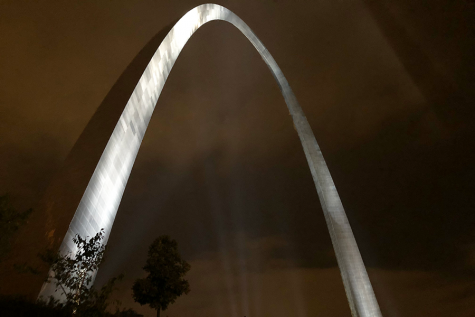Parking lot interruptions, primary wins and an Indian monsoon
Week of Aug. 20
Construction will limit the size of the EHS parking lot for the 2018-2019 school year.
Local
Know: All 20,930 RSD students returned to school for the 2018-2019 school year, Aug. 14. One-thousand-eight-hundred-fifty-five students began school at EHS.
Inform: Students returned to an altered campus. Not only do classes now begin and end 12 minutes later with a start time of 8:28 a.m. and a release time at 3:17 p.m, EHS has also gone down from three lunch shifts to only two. Parking lot restrictions also greeted students upon their return. Construction for the new S.T.E.M. building began the same day as school and has since caused interruptions. The South Entrance is currently closed, resulting in an alternate route for the buses to line up.The empty parking spaces north of the front circle will soon be staging area for construction. Eventually, the trees and creek that run in front of the school will be knocked down and paved over to create more parking.
Care: With construction making navigating the parking lot challenging, students will not experience the full effects of construction until January 2019. As construction continues, faculty parking spots will be moved, too. While all seniors who applied for parking spaces for the 2018-2019 school year received one, juniors who applied with only one other partner did not. The challenges presented by the construction are compounded by the fact that juniors and seniors won’t benefit from the new building since it won’t be complete until the 2020-2021 school year. The administration informed students at grade-level meetings that when construction is complete, campus will have 150 additional parking spots. However, these future spots do not help with the current parking shortage nor will those future spots ever serve those who are lacking spots now.
National
Know: Four states held primary elections, Aug. 14
Inform: The primary elections in Connecticut, Minnesota, Vermont and Wisconsin brought several firsts. Christine Hallquist (D) became the first transgender person nominated for governor by a major party. Hallquist won the Vermont Democratic primary with 48 percent. Ilhan Omar (D) won the Democratic primary in Minnesota for Congress. If Omar wins, she will be the first Somali-American member of Congress. Jahana Hayes (D) won the Democratic primary in Connecticut for Congress. If Hayes wins, she will become the first black Democrat from Connecticut in Congress.
Care: While it may have only been the primaries, these candidates have become one step closer to winning their respective seat. As a part of such a diverse group of candidates, these three women are knocking down the stereotypes of politics. By setting new standards, Hallquist, Hayes and Omar are opening up the world of politics for people of all identities. Election day will be Tuesday, Nov. 6. Anyone who is at least 17 and a half years of age is eligible to register to vote.
International
Know: A monsoon in southern India has resulted in over 350 deaths, Aug. 16.
Inform: Torrential rain in the Indian state of Kerala has caused massive flooding since Aug. 8. The floods have stretched over 6,000 miles, wrecking beaches, plantations and everything else that stood in its way. Forcing nearly 200,000 families to one of the 1,500 relief camps, all local schools and the local airport have shut down. The monsoon has taken the lives of 350 and counting, mostly because of landslides and falling debris. The Indian Meteorological Department removed the red weather alert, Aug. 19. While rain is still falling down, it is expected to slow over the course of the next few days.
Care: The rains have been called the worst to hit India since 1924. The tourism, cash crops and international trade industries have all suffered major losses because of the monsoon. Kerala exports rice, pepper, tea, coffee, coconut and cashews. President Donald Trump has enacted tariff after tariff, engaging the United States in a “trade war.” India entered the battle in July by imposing tariffs on U.S. goods, an effort expected to bring in $240 million for India. The Indian tariff has been called retaliation, as India joined China and the European Union to impose tariffs to combat U.S. tariffs on aluminum and steel. With trade tensions high, the added stress from the monsoon will leave a dent in India’s economy with $2.7 billion in losses.
Your donation will support the student journalists of Eureka High School - MO. Your contribution will allow us to purchase equipment and cover our annual website hosting costs.

This is Ethan's seventh semester on the News Production staff. In his free time, he enjoys taking photos, going to concerts and hanging out with his friends....

















